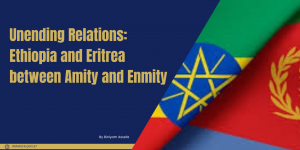The amity and enmity in Ethiopia-Eritrea relations have persisted since the formation of modern Ethiopia. Internal and external factors that drive the relations between the two states. From 1998 to 2018, the relations between the two states were characterized as “no peace, no war.” The political change in Ethiopia reshaped the Security and political landscape of the Horn of Africa. This change ended the “no peace, no war” relations between Ethiopia and Eritrea, and consequently led to cooperation on economic, security, social, and other aspects between the two states. On September 16, 2018, the Jeddah agreement is a testament to a new rapport between Ethiopia and Eritrea; the seven clauses that the two states made are a manifestation of new relations.
The rise of Abiy Ahmed reconfigured the Horn of Africa. It precipitated an alliance among Ethiopia, Eritrea, and Somalia to counter the balance of power and threats in the region posed by extra-regional powers and non-state actors. The deepening and widening of the two states are hindered by factors that impede cooperation between them. The War in the Northern tips of Ethiopia is a significant factor in the challenge. On November 3, 2020, the Tigray People Liberation Front attacked the Northern Command of Ethiopia, resulting in a war between the Tigray People Liberation Front and the Ethiopian Federal Government. This war ended in the Pretoria agreement between the Federal government and the Tigray People’s Liberation Front on November 2, 2022. The political animosity among Eritrea’s top echelon stems from the historical relations between the Tigray People’s Liberation Front and the People’s Front for Democracy and Justice (PFDJ), which is now the ruling party in Eritrea. The Eritrean government sought to prolong the war until the old guard of the TPLF was eradicated; however, the Ethiopian government preferred to negotiate with the TPLF. The relations between Ethiopia and Eritrea lasted from 2018 to 2022. The Pretoria Agreement marks a pivotal turning point in their relations.
Elements of Divergence in Teetering Ethiopia and Eritrea Relations
Eritrea was part of Ethiopia, which was a major Red Sea power, and it was a pivot point for international trade. Ethiopia was serving as a significant geopolitical and economic hub for commercial activity, trade, and interaction with several Asian and European states. Ethiopia’s ports, notably Adulis during the Axumite Empire and Asseb and Massawa in the 19th century, played a significant role in shaping Ethiopia’s international relations. And these two ports hold a significant position in Ethiopia’s national identity and its strategic role in International Politics.
Ethiopia’s economic and security are locked to this port, and Ethiopia’s greatness and imperial leadership in the Horn of Africa were unthinkable without the sovereign sea access. In 1993, Ethiopia became a landlocked state following Eritrea’s separation from its mother states, a historical injustice. The transformation of Ethiopia from a littoral state to a landlocked one, inverting its vulnerability and threat; the material and ontological security of the state faced vulnerability at a level not seen in its history due to regional and extra-regional actors in the Horn of Africa, which was compounded by the militarization of the region.
The Eritrean political elite’s psychological and cognitive orientation is a major factor in shaping the relations between the two states. These privileged elites consider Ethiopia a colonial power, and this political framework, since the 1960s, has shaped and reshaped the relations between states and beyond, impacting people-to-people relations. This thinking box stems from a flawed understanding of Ethiopian state formation, state building, and Italy’s colonization of the geographic territory of Eritrea. The state formation can be shaped by a critical juncture in the course of history. Warfare is part of state development, state-making, as well as state-breaking. Ethiopia’s state formation is not different from the well-known American sociologist Charles Tilly’s dictum of “war makes the state and the state makes war.” In the history of state formation, warfare served as a tool and means for the state formation. Eritrea’s being part of Ethiopia is the consequence of this strategy of state formation.
Eritrea was colonized by Italy for 51 years, from 1890 to 1941. The Eritrean elites consider this time as a period that created a distinct identity, and that makes Eritrea different from Ethiopia. The fact that today’s Eritrea has significant cultural, religious, and economic activity that is similar to Ethiopia. The inscription of different identities by the Eritrean elites is superfluous. The significant identity of Eritreans is an extension of the Tigray and Afar ethnic groups in both states. The role of the Ethiopian orthodox church is significant in the makeup of the two states and in shaping the society of the two states.
The political elites of Eritrea fused Eritrea’s state continuity in parallel to that of Ethiopia. And Eritrea’s biographical state continuity is dependent on considering Ethiopia as a threat, and Ethiopia is an objective existential threat to them. The Eritrea elites consider Eritrea to be distinct in terms of socioeconomic and political structure from Ethiopia, contrary to the fact that Ethiopia and Eritrea’s social fabric is intertwined. The two political entities were once unified, although they have since experienced discord due to the colonization of Eritrea. The relationship between Ethiopia and Eritrea has evolved and deepened over the course of history. There are cross-border ethnic groups between the two states. The Tigray and Afar are the two major ethnic groups that bind Ethiopia and Eritrea. The border between the two encompasses 641.9 miles or 1033 kilometres until it separates from Ethiopia, which is a historical injustice. And this length border relationship and attachment are significant in the business of the two communities.
The Eritrean political elites did not want to have consolidated relations with Ethiopia due to attributional errors in state problems. Internally, the political elites deemed Ethiopia a challenge to Eritrea’s statehood and the political miscalculations of the Eritrean state’s death; this made Ethiopia a perpetual enemy of Eritrea. Externally, the elites in power have not conducted a national election since it separated from Ethiopia, and the grand constitution has not been ratified. These elites diverted the citizens’ attention from questioning the authoritarian leadership style of the People’s Front for Democracy and Justice in the name of preventing the state’s death of Eritrea by Ethiopia.
The 1998-2000 Ethio-Eritrea border conflict reconfigured Ethiopia and Eritrea relations by adding layers to their divergent elements. This conflict is partly the result of historical animosity between the Tigray People’s Liberation Front and the People’s Front for Democracy and Justice (PFDJ), which manifested in interstate conflict and border disputes. The actuality of the conflict between the two rebel groups was horizontal conflict. However, this two-year-old conflict resulted in the deaths of more than 70,000 people. After the deadly conflict, the era of “no peace, no war” reigned and emerged as an explanation of the two-state relations.
From Cooperation to Stalemate
The Jeddah agreement ended the “No Peace, No War” policy and opened a new chapter in the relations between Ethiopia and Eritrea. The state-to-state and people-to-people relations, telephone services restored, and air travel resumed, with domestic political changes in Ethiopia, ushered in by Prime Minister Abiy Ahmed. However, from the beginning, the normalization of Ethio-Eritrea relations was challenged by a lack of institutionalization on the side of the Eritrean government. And in 2019, after the agreement, the Ethiopian government made efforts to consolidate relations with the Eritrean government in areas of port management, commercial activity, and small-scale trading activities at the local level but the Eritrea government rejected the widening and deepening of relations with Ethiopia due to the political leaders of Eritrea towards TPLF leaders and to keep balance of his citizens who bombarded in propaganda targeting Ethiopia as imperial who want to annex Eritrea. So, if the regime deepened its relations with Ethiopia, its propaganda would backfire.
The discord between Ethiopia and Eritrea reached its peak the day the Ethiopian Federal government sought a peaceful settlement of the war in the northern province of Ethiopia. This decision of the federal government was rejected by the Eritrean government because of the thwarted intention to eradicate the TPLF old guards and their intention not to accept a strong or weak Ethiopia. Fragile and strong Ethiopia poses security threats to the survival of Eritrea, as its modus operandi and framework of thinking. The president of Eritrea, Isaias Afwerki, expressed his dissatisfaction over the Pretoria agreement by saying, “There, they were presented with a document and asked to sign it. It was all arranged by the clique in Washington. The AU envoys – Obasanjo, Uhuru – were there for cosmetic purposes.” He expressed that it was imposed on the federal government by a foreign government, which is an enemy of Eritrea. This marked the first time the Eritrean government voiced against the peaceful settlement of conflict in the Tigray region.
The Pretoria agreement not only dissatisfied the Eritrea government, but it also dissatisfied political groups in the Amhara region. Some of the political groups’ demanded the neutralization of TPLF due to territorial disputes and political dissatisfaction with the TPLF-established political system in the country, as well as jingoistic nationalism in the region. At this moment, the political alignment and realignment emerged in the context of Ethiopia-Eritrea relations. The government of Eritrea engaged in arming, providing weapons and intelligence to insurgents in the Amhara region and old TPLF guards against the Ethiopian government and to routine hardliners of TPLF as an area-denial strategy for the war with Ethiopia. The Eritrean government continued business as usual, arming opponents which operates against the Ethiopian government. The ruling elites in Eritrea try to subvert Ethiopia to get strategic superiority and ideological and geopolitical advantages in the region. Before 2018, the Eritrea government was hosting several liberation fronts, and arming opponents is the continuation of the government’s policy at the expense of Ethiopia’s state biographical continuity and to abort the sovereign maritime access.
The Prime Minister, Abiy Ahmed, remarked on Ethiopia’s sea access and the raison d’être of the sea for the largest country in the Horn of Africa, with a population of 130 million, highlighting the vulnerability and unsustainability of Ethiopia as a prisoner of geography. Breaking this geography is necessary, as the prime minister asserted, by any means necessary. This speech of the Prime Minister was misrecognized. The government of Eritrea analyzed that Ethiopia is going to invade them. This misrecognition further fractured the relations between Ethiopia and Eritrea. During this diplomatic deadlock with Eritrea, the memorandum of understanding was inked between Ethiopia and Somaliland on January 1, 2024, for the use of the port in Somaliland and recognition of Somaliland by Ethiopia.
The minilaterlism established by Eritrea, Egypt, and Somalia to counter Ethiopia in the region rather than to protect the region’s security and peace. The objective of this minilateralism is to undermine Ethiopia’s national security and interests in the region. Egypt has engaged in obstructing Ethiopia’s right to development over the Nile. Eritrea, as usual, stands against Ethiopia’s interest in the region and the security of the Horn of Africa. And Somalia postured against Ethiopia’s sea access and withdrawal of Ethiopian forces from peacekeeping in Somalia, and invited Egypt. The declarations of Ankara reconfigured this minilateralism by restoring diplomatic relations between Ethiopia and Somalia. However, Egypt and Eritrea continued their pact against Ethiopia.
The geostrategic and geoeconomic significance of Ethiopia is highly entangled with ports. The role of Ethiopia with sovereign maritime status will be bigger than its current landlocked status. Interestingly, Ethiopia’s elites’ perception of threats changed, and the Horn first doctrine policy manifested in states’ engagement with the Greater Horn of Africa states. Additionally, Ethiopia can realize its potential and transform itself from an imperfect to a perfect hegemony by focusing on the twin grand strategies, namely, Nile Politics and Port Politics. In the ever-changing security dynamics in the Horn of Africa, the politics of the port play a significant role in the teetering Ethiopia-Eritrea relations. Ethiopia-Eritrea relations are unviable without port access. The fates of the societies in Eritrea and Ethiopia are inextricably intertwined.
The enmity between the two states has been characterized by high-intensity and low-intensity conflict throughout history. However, there has been a discontinuity in the transition from enmity to amity. The political elites in Eritrea, after assuming power, redefined the Eritrean people in relation to Ethiopia. The elites consider Axumite history as prehistory to delink the historical connection of the two peoples. The People’s Front for Democracy and Justice (PFDJ) focuses on the difference between the Ethiopian people and Eritrea, and it is intransigent on the element of divergence and division of the communality of the people. The Ethiopian government must work in reverse to the policy of the Eritrean government by focusing on the communality and similarity of the two peoples, particularly on the Tigray and Afar peoples.
The climax of discord between Eritrea and Ethiopia’s relations is the conclusion of the Pretoria agreement. The political elites of Eritrea were interested in neutralizing the old guards of TPLF due to historical animosity; however, the federal government of Ethiopia preferred a peaceful settlement. After the agreement, Eritrean soldiers are still challenging the territorial integrity and sovereignty as well as interfering in the internal issues of Ethiopia through arming insurgents. African Union and IGAD must intervene in restoring the relations of the two states, and they must act on Eritrean Foreign policy driven by jingoism and expansionism. The political elites of Eritrea are well known for shouting at their neighbors, including Yemen. Revanchism and bellicose rhetoric are the major characteristics of the leaders in Asmara.
About the Author
Biniyam Assefa is Canada based Independent researcher on Peace, Security, Terrorism and Geopolitics in the Horn of Africa. He holds BA and MA degree in Political Science and International Relations, and Peace and Security Studies from Addis Ababa University.
Disclaimer:
The content disseminated by the Institute of Foreign Affairs (IFA) – including, but not limited to, publications, public statements, events, media appearances, and digital communications – reflects the views of individual contributors and does not necessarily represent the official positions or policies of the Institute, its partners, or any affiliated governmental or non-governmental entities.
While the IFA endeavors to ensure the accuracy, integrity, and timeliness of the information presented, it makes no representations or warranties, express or implied, regarding the completeness, reliability, or suitability of such content for any purpose. The Institute expressly disclaims any liability for errors or omissions, as well as for any actions taken or decisions made based on the information provided.
The inclusion of external links, references, or third-party resources does not constitute an endorsement by the Institute. Additionally, engagement on social media platforms – including, but not limited to, likes, shares, retweets (RTs), or reposts – shall not be interpreted as an endorsement or validation of the views expressed therein.


















